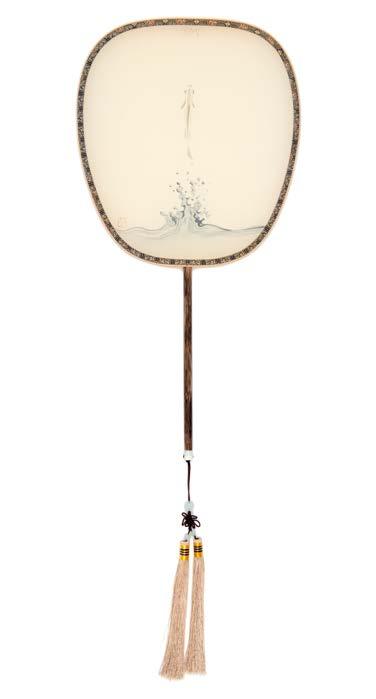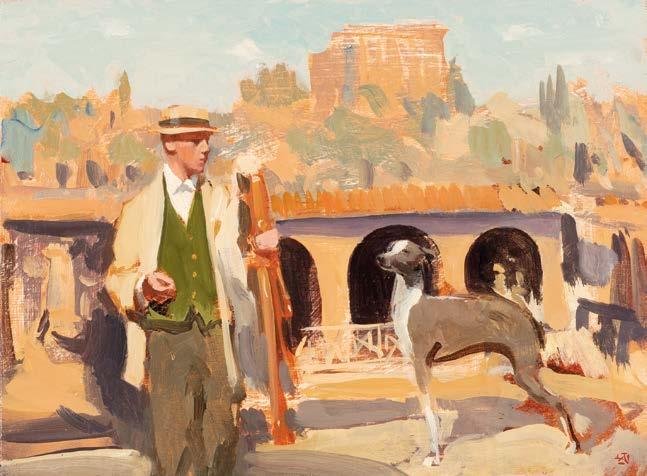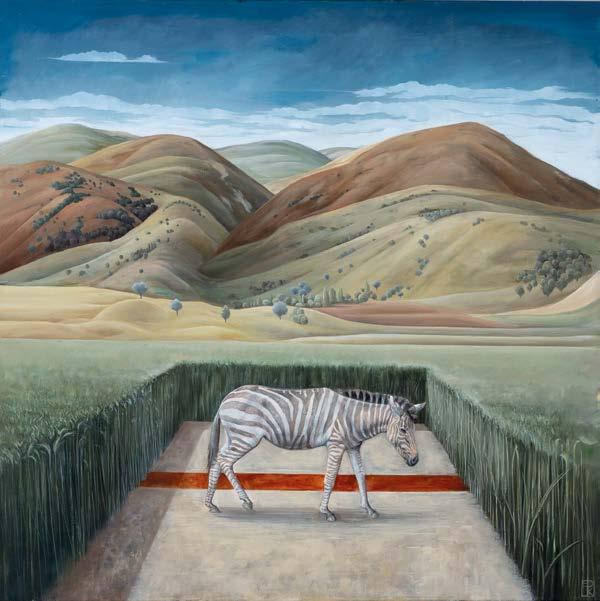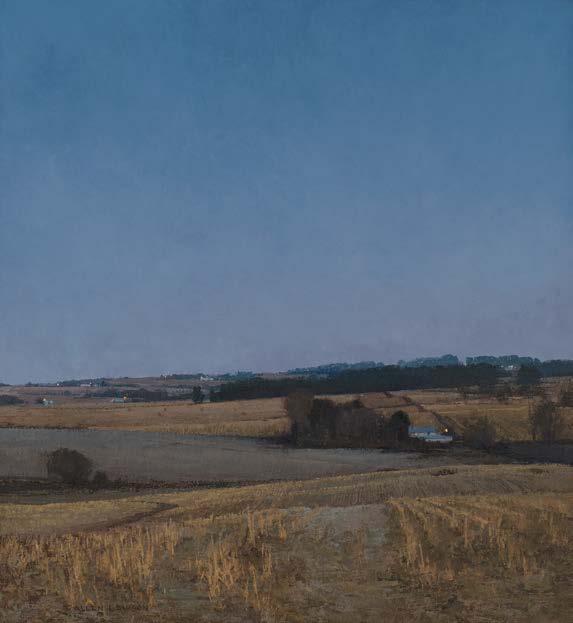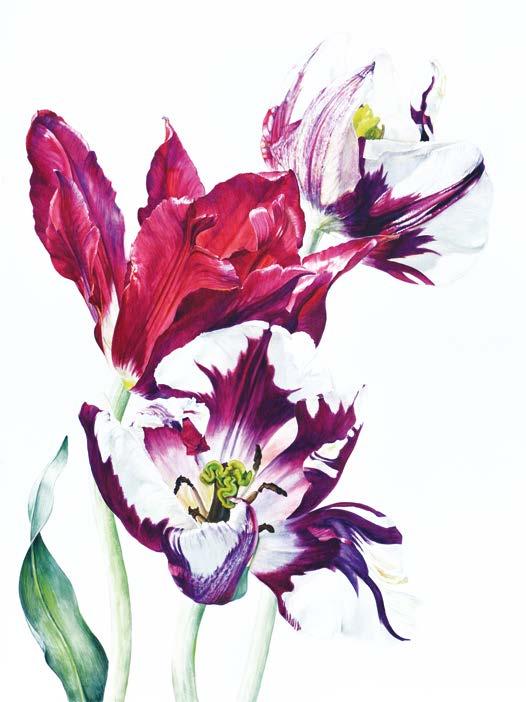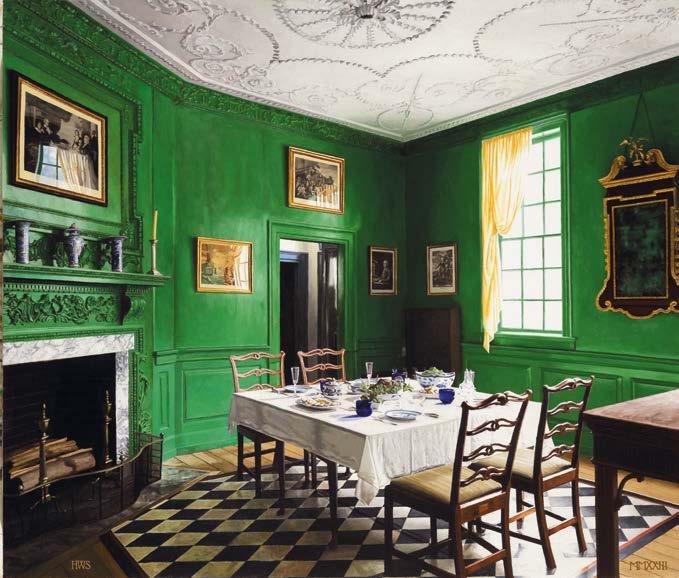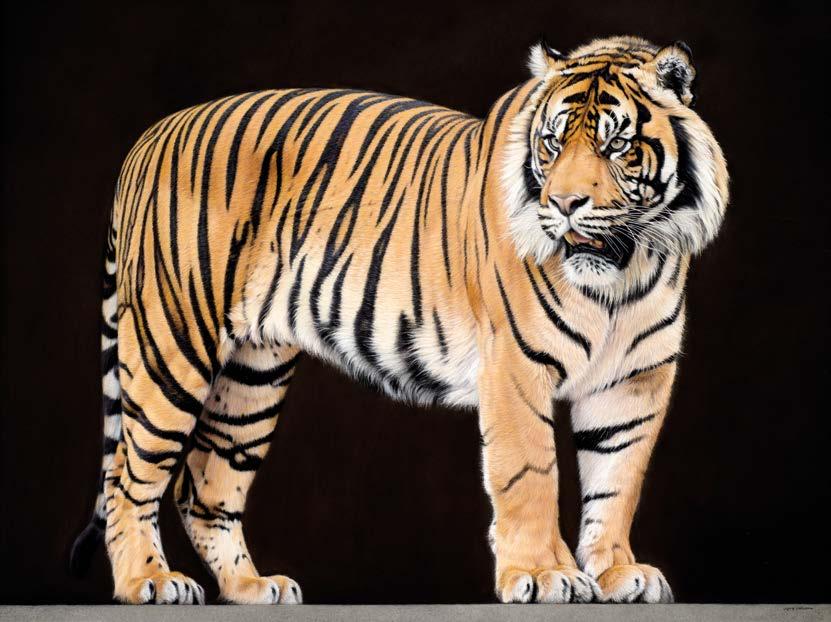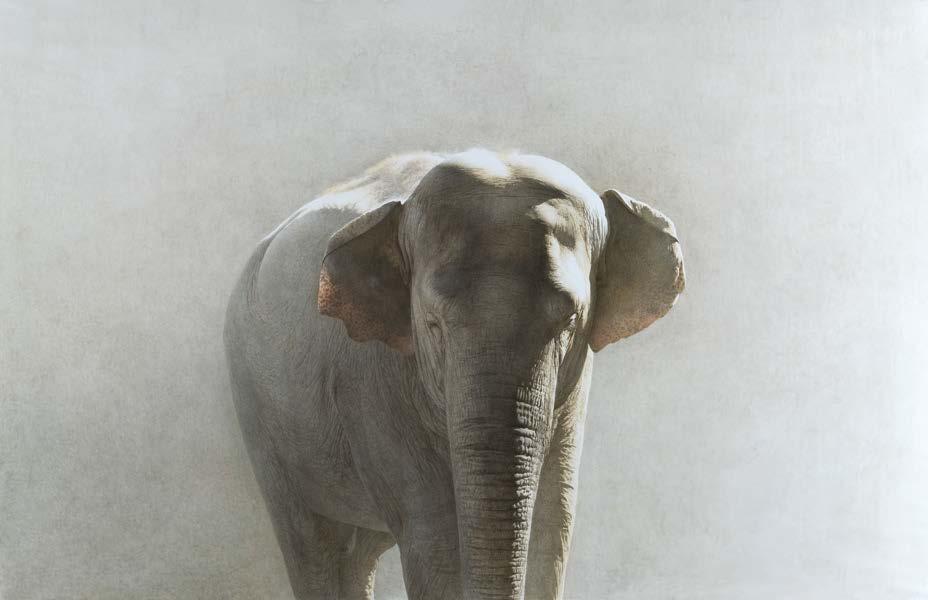CRAIG WYLIE
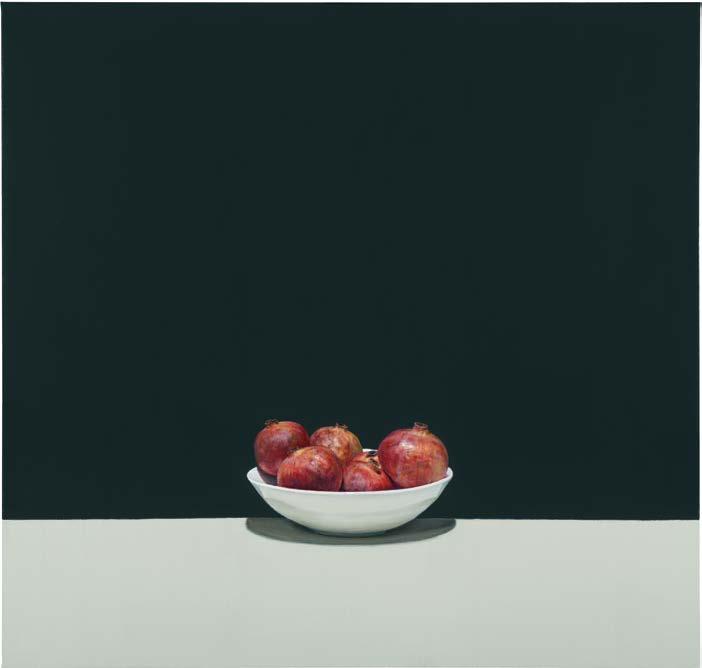
37
Raft (After Courbet), 2023
Oil on canvas 39.37 × 41.34 ins (100 × 105 cm)
It is now five years on from our 30th Anniversary Exhibition of being here in Park Walk. We all have had a few challenges in that time, notably the pandemic. However, this period of time allowed us to adapt and, in a way, thrive. Our international clientele was able to reach us through our website and social media, there is a golden thread in this modern world.
We have been fortunate to continue to discover international talent that has joined our established valued artists. We now represent artists from across the globe, from Australia, to China, France, Italy, Northern America and England too. This range of talent I believe old and new to be exceptional. What is important to us is that they know how to make a good painting and at times a great painting, so we live in expectation.
Our expertise is broad, but the Natural World plays a very important part in what we do. Perhaps this is unusual, there are many Modern British dealers, some I have the greatest respect for, but not many who do what we do and that is the difference as far as I am concerned. My father said to me, Jonathan stay down the track and I have.
I would not be able to operate without my colleagues, again old and new, Alice Phillimore, Rebecca Wall, Alice Cooper and Patrick Ramsay, my business advisor. Poor Patrick, he had a battle on his hands, but he moulded us to be more efficient, well sometimes! Melissa Tahar, my wonderful French colleague, has been indispensable, her vision coincides with mine and her taste in a painting, I have never known better, she is God sent. I am grateful for Gali Cabili for her understanding of the powers of social media, much needed by myself as I am a dinosaur. Yan Wang from Shanghai, who apart from introducing me to the great He Xi, enables us to speak with each other, rather than just smiling on the phone. He does not
speak a word of English and I, no Chinese. My secret weapon is Graham Rees, he designs everything we print, he does this so well. He is used by some of London’s best galleries. Finally, Huon Mallalieu, once again for agreeing to write the catalogue preface. He has done it before, he writes beautifully, and I believe he admires what we represent.
My huge thanks go to our clients, without them it would be impossible to operate. I hope we do them proud and that they enjoy what they have bought.
It is important to mention those that we have lost, in particularly from America Arnold Fisher KBE, and from Thailand Vichai Srivaddhanaprabha, both philanthropists and supporters of my artists, we were so privileged that they choose to come here when the World was their oyster. My mother left us in February this year. She I know would have loved this catalogue and we would have gone through it together in great detail. What enthusiasm, it was infectious.
Will I be here in another 35 years, I very much doubt it, but I would hope the legacy of excellence will live on, perhaps this will be in Bond Street or 5th Avenue, or some other centre of fine art.
This gallery has opened many doors and has developed in such a way that was almost inconceivable 35 years ago. Long may it continue.
Jonathan Cooper, 2023
LEE ANDRE (b.1966, Korea)
Great Egret, 2023, plate 1
Selecting animals as a subject matter offers an abundant source of diverse forms and inspiration. When an animal enters our world, we are often captivated, filled with both excitement and caution. It is this curious longing to observe and connect with each unique creature that forms the basis of my work. The image showcased here originated from a serendipitous encounter with a great egret outside my home. It gracefully wandered in silence before elegantly taking flight.
Lee Andre, July 2023
Lee Andre was born in Korea and adopted at the age of five by a family in Minnesota. From an early age, she displayed a strong inclination towards drawing, which eventually led her to pursue art school, earning a BFA from the University of Washington. After working as a muralist for a decade, she put her career on hold to travel and live abroad. In 2016, driven by a desire to reconnect with her art, Lee settled in Florida and reestablished her studio practice. Her vision evolved after discovering old black and white photos capturing a drama-free, uncomplicated world. Using charcoal and limiting her palette to black and white, her work delves into the essence of the past, reflecting on a simpler and more nostalgic era.
MICHAEL J. AUSTIN (b. 1959, United Kingdom)
Inception, 2023, plate 2
My driving passion in my work is to create life. To mould the paint in such a way that it becomes alive and divorced from the technicalities of painting. If I achieve this, then I am happy.
Michael J. Austin, July 2023
India and Oman as Tour Artist. In November 2016, he again accompanied HRH Prince Charles, together with HRH the Duchess of Cornwall, (now King and Queen), on a tour of the Middle East, visiting Oman, the UAE and Bahrain. He exhibits at many leading international art fairs and exhibitions with Jonathan Cooper, London.
Initially apprehensive about painting horses due to their common portrayal, the artist eventually embraced a transformative artistic approach. By employing a skilful use of minimalistic colours, he elevated the horse beyond a mere representation, capturing its essence in a captivating and magical manner.
HARRIET BANE (b.1958, United Kingdom)
The Panther, 2023, plate 3
I have really pared down this painting. These animals are rare to see in the wild and are declining in numbers. I deliberately put the panther in a hostile landscape, denuded of life, sparse and barren, not the usual habitat of dense green jungle. The panther is moving on, leaving.
Harriet Bane, July 2023
Harriet Bane, originally from Bath and raised in the West Country, lives and works in Guernsey. Trained at Wimbledon School of Art where she received a BA (Hons) in Stage and Theatre Design, Harriet Bane’s artistic journey was influenced by minimalism, which instilled in her a disciplined approach to composition. Inspired by her island home’s natural beauty and colours, as well as early explorers’ records of flora and fauna, Harriet’s work reflects her passion for preserving endangered species and capturing the essence of wildlife through painting.
JOSEPH BLACK
(b. 1992, United Kingdom)
Icelandic Poppy, 2023, plate 4
Michael J Austin lives and works in Devon. In 2003, he was invited by HRH the then Prince of Wales to accompany him to
As things come and go, they show signs of their coming or going,
and these signs I consider to be most beautiful. Flowers in bud, or things in decay, as it were, suggest the transience of things. In my work I like to pair contrasting objects, some timeless and others fleeting. I think in turn this shows the fragility of both and allows us to reflect on the changing course of our own lives. In this work I have been inspired by the Fates of Greek Mythology (Moirai); three deities which determine and spin the course of our lives. I have represented them as poppies with their face turned away from us to suggest the unknowable and inscrutable future.
Joseph Black, July 2023
Joseph Black lives and works in Kent, where he has his own studio. He trained at Camberwell College of Art, graduating with a BA Hons in Painting in 2015, followed by a Master’s degree in the History of Art from The Courtauld Institute of Art in 2016.
Joseph Black’s art intricately weaves technical precision with a poetic and tranquil sensibility. Through a muted palette and focused composition, he isolates subjects against simple backgrounds, revealing profound metaphors in the natural world.
TANYA BRETT
(b.1974, United Kingdom)
Polar Bear, 2023, plate 5
I have always been drawn to Animals as a child, polar bears more than most. The porcelain I use particularly lends itself to their iridescent colouring. I love that each piece I make in ceramic is a complete original and you can see my fingerprints. I coil the clay up from the paws and continue sculpting. Then high fired to Stoneware.
Tanya Brett, July 2023
Tanya Brett, based in London, holds a BA Hons in Three Dimensional Design from the University of Brighton and has showcased her work in solo exhibitions at Jonathan Cooper, The Sladmore Gallery, and group exhibitions at The Armory in New York along with Adrian Sassoon.
Tanya Brett’s sculptures, whether crafted in bronze or ceramic,
exude an impressionistic style. Their irregular surfaces, as well as the artist’s spontaneous gestures, infuse the depicted animals with an astonishing vitality.
ELIZABETH BUTTERWORTH
(b.1949, United Kingdom)
Blue and Yellow Feathers, plate 6
I was given a scarlet macaw when I was at the Royal College of Art by my then boyfriend. Some time later I did some paintings of him which I exhibited at my first show with Angela Flowers. I became increasingly interested by the subject and decided to make a book of etchings on Parrots and Cockatoos studying them at London Zoo, The Natural History Museum Bird Collection and European Zoo collections. This was followed by a book on Amazon Parrots which involved travel in South America and was exhibited at the Metropolitan Museum, New York. I am forever fascinated and in awe of the colours and beauty of these incredible creatures, and I am always searching for different ways to portray their beauty.
Elizabeth Butterworth, July 2023
Elizabeth Butterworth, an esteemed ornithological artist, was born in Rochdale, Lancashire, and currently resides in Sussex. Her exceptional depiction of Macaws was lauded by art historian and critic Ian Dunlop as “without rival this century”. She received her art education between 1966 and 1974, attending Rochdale School of Art, Maidstone School of Art, and the Royal College of Art in London.
Her artistic career features significant exhibitions at the Redfern in 1997, 2001 and 2009. In 2001, she showcased “Amazons, Macaws, and Cockatoos” at London’s Natural History Museum. Elizabeth’s talent has reached a global audience with five solo shows in the USA, including an exhibition at the Metropolitan Museum of Art, New York, in 1985. Her work has also been displayed in galleries in Ireland and Australia.
Her artistry is widely recognized, with over twenty-five institutions worldwide showcasing her work, from museums and libraries
to contemporary art collections, public galleries, and university collections.
REBECCA CAMPBELL (b.1965, United Kingdom)
In a Bit of aTwitter, 2023, plate 7
Farid ud-Din Attar’s epic allegorical poem ‘The Conference of the Birds’ is considered widely as a masterpiece of Persian literature. ‘A Bit Of A Twitter’ is from the opening lines where all the birds of the world gather at a summit in order to seek a king. They turn to the wise hoopoe for guidance, who tells them that they should acknowledge the Great Simorgh as their king, but that the journey to his court is long and perilous, and filled with trials and tests. At first, the birds are excited to embark on this quest, but begin to make excuses to stay behind when they realise the quest’s difficulty. The hoopoe addresses each of their hesitations, fears, vanities, and questions with parables and anecdotes that counter each of their individual concerns. The birds formally adopt the hoopoe as their leader, and the hoopoe describes the seven valleys they must cross in order to reach the Great Simorgh’s court: the Valley of the Quest, the Valley of Love, the Valley of Insight into Mystery, the Valley of Detachment, the Valley of Unity, the Valley of Bewilderment, and, finally, the Valley of Poverty and Nothingness. Many of the birds are distressed by the hoopoe’s words but despite their apprehensions, the birds begin their journey.
Aside from the chance to illustrate this wonderful story of perseverance and belief, another reason for creating this painting is that the hoopoe is my favourite bird!
Rebecca Campbell, July 2023
Rebecca Campbell, based in London, possesses a distinctive and narrative style of work, honed through her training as an illustrator. Her paintings are described as delightful, enigmatic, and imaginative, reflecting a keen sense of colour, design, and humour. Influenced by her upbringing in the Irish countryside, her art showcases a world of variety, eccentricity, and joy. She has
been deeply influenced by her extensive travels, especially in India, which continue to hold a central place in her work today. In addition to paintings, Rebecca has undertaken commissions, including murals, illustration, and design projects, and has collaborated with Good Earth, India, and Globetrotter. Exhibiting her paintings since 2002 at Jonathan Cooper, London, she has also showcased her art in the United States, Mexico, and Canada. Her work has been published worldwide in books, magazines, and as greeting cards. Notably, Campbell actively participates in large public art events, serving as the in-house artist and Ambassador for the charity Elephant Family.
ANDREA COLLESANO (b.1980, Italy)
Patronus, 2023, plate 8
I live far away from the city chaos; I find my inspiration by listening to the music of nature, carried to me by the wind through the window of my studio in the Tuscan countryside. In this silence, so rich with heavenly sounds, the images come to me, which I then capture on paper with ink. We are all part of the universe; we ourselves are stars, we are sky and earth, we are water and fire. The animals I have always drawn emphasize this concept: we are all connected, us to them and them to us. And both humans and animals share flowers and plants. Even the tiniest blade of grass can gift us with a useful and beautiful flower. The planet that hosts us gives us the opportunity to evolve spiritually in the face of the immense work of nature. You can look into the eyes of the animals I depict to try to understand their mysteries. I wish for the viewers to discover every little detail of my new drawings, to get lost among the tiny bees, to follow their buzzing as they fly from a chamomile flower to that of a wild thistle. The small key represents the possibility of making a choice. Free will. Let us choose to respect nature, let us learn to enjoy its beauty without harming it.
Andrea Collesano, July 2023
Andrea Collesano, born in Pontedera, graduated in Painting at the Academy of Fine Arts, Florence. His thesis focused on the analysis of metaphoric and mythological figures in Bocklin’s paintings, with particular attention to their zoomorphic aspect. Currently based in Forte dei Marmi, he explores a wide array of subjects in his art, from miniature depictions of tiny insects to grand compositions featuring whales and enigmatic abyssal creatures. Through his creative process, Andrea Collesano seeks to bring to life the intricate world that resides within his imagination.
GENEVIÈVE DAËL
(b. 1947, France)
L’Attente II, 2020, plate 9
“Never the same painting, always the same theme.” It’s my obsessive side. It’s difficult to verbally express what precisely determines the choice of each painting. But in a few words:
It’s the constant pursuit of an ideal poetic expression, of a place, a moment filled with memories where silence carries everything away. This is so well summed up for me by Leonardo da Vinci’s phrase: “Painting is a silent poetry.”
Geneviève Daël, July 2023
Geneviève Daël, born in 1947, is an artist based in Montmartre. She studied Decorative Arts at the Académie Charpentier and later returned to Paris after a brief stay in London. There, she embarked on independent painting studies while also working as a model for Dior. In 1984, she had her first solo exhibition with Francis Kyle in London, followed by nine more solo shows alongside numerous themed group exhibitions.
In her paintings, Geneviève Daël captures enigmatic interior scenes with meditative female figures, evoking a lyrical ambiance akin to the Northern European traditions of the Dutch Golden Age and Hammershøi.
ALISON ELLIOTT (b. 1965, United Kingdom)
‘Rebecca’ a Japanese Chin, 2023, plate 10
As an artist it is part of the creative process to identify, develop ideas and subjects which inspire and communicate to us. The focus on the dog is emphasised by my simplistic and striking style of ‘cut-out’. Each blank canvas provides that integral space for each subject to project itself from. My ultimate goal is to capture the mood and feeling of that dog, so much so, that you can almost feel them breathing rather like a ‘tableau vivant’. The beauty of my paintings is achieving this.
Alison Elliott, July 2023
Alison Elliott was professionally trained at Winchester School of Art and Newcastle Polytechnic. She has exhibited with the Society of Equine Artists at Palace House in Newmarket and at Tattersalls Yearling Sales. In October 2014, Alison won the Curwen Gallery Prize for Figurative Painting. In July 2015, she had her first major solo exhibition with the Curwen Gallery in London. Her painting of ‘Betty Boop’ was selected for the Columbia Threadneedle Prize in 2015.
Inspired by the old masters, she paints dogs and horses in a classical style, using traditional oil techniques. Her profound affection for her subjects shines through in her artwork, where she meticulously depicts the minutiae of the animal’s form.
ANGUS FISHER
(b.1983, Australia)
Gymea Lily, 2023, plate 11
The Gymea Lily is one of Australia’s most spectacular flowers. It is a hefty plant growing to 20 feet tall and one that showcases the most spectacular pallet of colours through its blooming cycle. It is a plant that is hard to miss and harder to resist. My drawing style is based on my training as a printmaker and the studies of the many etchings and engravings of Gymea Lilies completed since
early European settlement of Australia. I approach my drawing as I would a traditional etching with a strong focus on line-work, building up form mark by mark with fine ink pens. The colour washes come last to tint the drawing in the manner of a handcoloured etching
Angus Fisher, July 2023
Graduating with distinction in 2010 from the National Art School, Sydney, Angus Fisher is regularly exhibited in Australia. His diverse experiences include working as an archaeological illustrator in Greece, collaborating with Aboriginal artists in Australia’s Northern Territory, and currently teaching in the Printmaking Department at the National Art School, Sydney. His art is featured in numerous public and private collections, including the National Gallery of Australia and the Art Gallery of NSW.
Angus Fisher’s art delves into the evolving concept of nature and its connection with humankind, exploring it through deep historical and natural subject studies.
AYESHA GAMIET
(b.1982, United Kingdom)
Valley of Unity, 2023, plate 12
‘Valley of Unity’ is one of a series of paintings inspired by Attar’s medieval Persian epic, ‘The Conference of The Birds’. The poem describes how the birds of the world set out on a quest to find their King, the mythical Simurgh. Led by the wise hoopoe, they journey through seven valleys: the Valley of The Quest, Love, Insight, Detachment, Unity, Awe and Bewilderment, Poverty and Nothingness. The poem is a metaphor for the soul’s seeking of the Divine, with each Valley representing a spiritual station on that path. In the ‘Valley of Unity’, the birds realise the essential oneness underlying the diversity of creation. The sun is a timeless symbol of unity and eternity, and to illustrate this, I have used a motif known as a shamsa (meaning “little sun”) as the central panel for this painting. I drew upon my training as a manuscript illuminator in the Islamic tradition to design, gild, and paint
this intricate centrepiece. To reflect the idea of underlying unity in the diversity of creation, almost every bird in this composition represents a national bird from a different part of the world. From the Ukrainian white stork to the Syrian Northern bald ibis, these birds are bathed in the radiance of golden sunlight as they travel through the ‘Valley of Unity’, a dimension beyond time and space.
Ayesha Gamiet, July 2023
Ayesha Gamiet is inspired by nature and the magic of the everyday. Her love of art and books led her to study Islamic manuscript illumination and painting in London and Istanbul. She exhibits her work in the United Kingdom and internationally. In 2018 Ayesha was commissioned by the Royal Library to paint illuminated frontispieces to a poetry collection gifted to the late HM Queen Elizabeth II and then HRH Prince Charles. Her work forms part of the Royal Collection at Windsor Castle and is held in collections internationally.
DAVID GROSSMANN (b. 1984, USA)
Dusk Flight with Moon, 2022, plate 13
This painting is inspired by the view near my home where I often go to watch for birds and to observe the colours of the sky. I particularly love this place at dawn and dusk when shapes dissolve into each other and the sky becomes a palette of subtle transitions. The valley where I live is an extensive avian migratory route, so from day to day, one season into the next, I am accompanied by birds. For me they embody hope, and they are also reminders of the fragile balance of our world. This painting is my attempt to capture that sense of fragility and of hope that are built into the patterns of our lives.
David Grossmann, February 2023
David Grossmann, born in Colorado and raised in South America amid the Atacama Desert and the Andes Mountains, lives with his wife and son in Colorado, USA.
David Grossmann explores the space between nature and the inner landscape of perception and contemplation, intuition, and memory. Through the use of imagery that captures the passage of time, he attempts to convey the fragile balance of the environment and the patterns of loss and renewal that play out in the natural world. His paintings take shape in a slow progression that allows each to become a meditative, reverent space.
YASMIN HAYAT (b.1990, United Kingdom)
The Partridge, 2021, plate 14
The Partridge is an Indian Miniature painting in the style of the Lucknowi - Mughal master painters. Famed for microscopic detail, soft hair-like brush marks and characterisation of the subject manner, The Partridge is a work that asks to be admired and contemplated. Using a magnifying lens and a curly-haired squirrel brush, I carefully painted feathers a single stroke at a time. 23 carat gold was hand-ground into pigment before being used to border and celebrate the bird, which sits proudly upon a textured mulberry paper which has been handmade.
Yasmin Hayat, July 2023
Yasmin Hayat is an award-winning artist who graduated from Central Saint Martins (University of the Arts London) before specialising in Indo-Persian Miniature painting at the Prince’s Foundation School of Traditional Arts. Drawing from her Syrian heritage, Yasmin’s art seamlessly blends an old Arabic style with contemporary Western, Indian, and Persian techniques. In 2018, she received the Kairos prize from His Majesty King Charles (then Prince of Wales) and Professor Keith Critchlow for preserving and celebrating traditional art practices. Yasmin’s collaborations include notable names such as Soane Britain and The British Museum. In 2023, The Aga Khan Museum added two of Yasmin’s ceramics to their permanent collection.
TIM HAYWARD (b.1952, United Kingdom)
Peregrine Falcon - Green, 2023, plate 15
For as long as I can remember, birds have held a fascination for me. When I was young, they were abundant and captivating, but these days they are fewer and seem even more precious. Perhaps it’s the case that in our increasingly tech-driven and disconnected time, nature restores in us some balance and perspective.
Isolating a bird against a simple background serves to emphasise its form and colour, as both a graphic subject and a sculptural object to admire and wonder at. It’s a subject I continue to explore and learn.
Tim Hayward, July 2023
Tim Hayward, based in Somerset, is an accomplished wildlife artist who previously worked as a respected illustrator for organisations like the Royal Society for the Protection of Birds, Readers Digest, Hamlyn Publishers, amongst others. His work is included in institutions such as the Natural History Museum in London and the Noorder Dierenpark in the Netherlands, and in prominent private collections worldwide. Hayward’s masterful portrayal of birds not only showcases his profound bond with wildlife but also reveals his deep fascination with these creatures.
BEN HENRIQUES (b. 1967, United Kingdom)
Cosmos, 2022, plate 16
In still life painting, or as the French say - Nature Morte - there is no better means of confronting the big issue. Even in the most apparently bright and airy still life there are always pensive undercurrents.
Ben Henriques, July 2023
Ben Henriques’ meditative work captures the beauty in the simplicity of everyday objects and familiar life forms.
After honing his skills at the University of Newcastle in the late 1980s and earning a Fine Arts degree in 1990, Ben Henriques moved to London, standing out for his direct approach to subjects and admiration for traditional painting techniques. His talent caught the attention of prestigious galleries, including the National Portrait Gallery, who invited him to exhibit a self-portrait, and William Hardie Gallery, where he had his first commercial show. Following his journey to South Asia, where he found new inspiration, he returned to London in 1995 to showcase his paintings at major galleries like Lefevre, Browse and Darby, and Agnew’s. In 2001, he had his first solo exhibition at Jonathan Cooper.
HE XI (b.1960, China)
Moment of Happiness, 2023, plate 17
Breeze, 2023, plate 18
There were many kinds of fans in ancient China, though only the Zheshan (folding fan) and Tuanshan (round fan) have grown to receive true appreciation from art collectors.
The birth of the round fan predates that of the folding variety. Its shape, like a full moon, signifies the auspicious meaning of a union and happiness.
Fans are not only tools for cooling oneself, but also symbols for status and taste. Scholars would wave their fans to show off their grace as they composed poetry or sat deep in thought. When not in use, fans were sometimes concealed inside sleeves or hung from the waist. For aristocratic young women, fans made from silk or other precious, especially flat round ones, were a kind of prop to showcase grace and beauty. Whenever they met a stranger, they would use their fans to hide their face. Hence, women’s fans are also known as ‘Zhang mian,’ which means ‘Hiding face’.
Fans gradually came to have attachments, such as fan bags, fan pendants and fan boxes. Fans also spread to other countries in the world, especially to Europe, becoming “emissaries” for Chinese culture.
He Xi, July 2023
Shanghai-based artist He Xi trained at the Shanghai Arts & Crafts Vocational College and the Chinese Painting Department of the Zhejiang Academy of Art (now the China Academy of Art). His remarkable work is influenced by the tradition of Chinese painting while distinctly reflecting his unique artistic vision and style.
He Xi is a member of the Shanghai Chinese Painting Academy, and the China Artists Association; a syndic of the Shanghai Artists Association, and a committee member of the Chinese Painting Committee; He is a professor at the Shanghai Institute of Visual Arts, and an adjunct professor and Postgraduate tutor at the Shanghai Academy of Fine Arts, Shanghai University.
His work has been the subject of numerous solo exhibitions in museums such as the China Academy of Art Museum, the Suzhou Museum, and the Shanghai Chinese Painting Academy Art Museum. His work has been acquired by the National Museum of Wildlife Art (WY, USA) and the Museum of Fine Arts, Boston (MA, USA).
ALAN KINGSBURY (b.1960, United Kingdom)
Roman Holiday, 2001-2002, plate 19
This small painting was made in 2001-02 for an exhibition entitled Rome, but on completion it became an immediate favourite, and I kept it back for my own collection. It has never been exhibited before this year.
It is, in effect, my own vision of a personal grand tour. The man is accompanied by an Italian greyhound; an elegant breed dating back to antiquity which was highly prized by the renaissance aristocracy. He holds a large zampogna, a musical instrument played in Rome by country folk who came into the city from the Abruzzi mountains.
I have a particular interest in fresco painting from ancient times and the Renaissance period, and this scene, bathed in Mediterranean light, is set before the House of Livia, part of the Augustan residence in Rome, which was adorned by many frescoes.
Alan Kingsbury, July 2023
Alan Kingsbury studied Art History at the University of Wales and the New Academy for Art Studies specialising in Old Master and modern European painting. He is an elected Academician of the Royal West of England Academy, and his work has been exhibited at numerous galleries and art fairs in the United Kingdom and abroad, including the Royal Academy of Arts, The New English Art Club, and The Royal Society of Portrait Painters.
RON KINGSWOOD (b.1959, Canada)
Evening Shift, 2023, plate 20
One will often hear owls in the evening, but rarely see them. Most of their activity occurs between the sun setting and rising, during the darkest hours of the night. In this painting, entitled “Evening Shift,” I wanted to show the owl starting his evening hunt after leaving the roost tree.
Ron Kingswood, July 2023
Ron Kingswood currently lives in Sparta, Ontario, studied at H.B Beal in London, Ontario, and holds a degree in Bird Ecology and Ornithology from The University of Western Ontario. His artwork has been exhibited internationally and is part of prestigious public collections in the USA and Canada, including The National Museum of Wildlife Art (WY); Ella Sharp Museum of Art (MI); Foothills Art Center (CO); Leigh Yawkey Woodson Art Museum (WI); The Virginia Museum of Fine Art (VA); and London Museum, Ontario.
Through his paintings, Ron Kingswood seamlessly blends his passion for nature with a deeply personal and subjective approach. His expressive brushstrokes and inventive compositions strive to convey the remarkable force of colour.
JEANNIE KINSLER
(b. 1963, United Kingdom)
Poised, 2023, plate 21
My work often depicts the same objects, things held dear, a cast of characters collected and rearranged. These items are imbued with a sense of time and place, and the collection of vases and fragment of vintage cloth here do lend an air of a time gone by. All brought to life by the slight, elegant forms of the cut geums. There are layers and history also to the application of paint, a lightness of touch yet considered and complete.
Jeannie Kinsler, July 2023
Born in 1963 in England, Jeannie Kinsler spent significant years in Southern Africa where she was raised, and later returned to the UK in 2019; she studied painting in oils at Pascale Chandler’s studio in Durban and now operates from her home studio near London. Jeannie Kinsler’s artwork draws inspiration from her surroundings and the people she cherishes, incorporating elements of everyday and antique objects, nature, and found items. Within her paintings, Jeannie Kinsler skillfully uses the interplay of light and shadows to dissolve and unite the forms, while her adept use of aerial perspective adds a contemporary dimension to her work.
SAMUEL KIRK
(b.1998, United Kingdom)
Lost Stripe, 2023, plate 22
My paintings are set in landscapes which are familiar but unplaceable - they are places where the background has become the foreground, where the idea of a place is represented. My paintings depict the setting of story which has not happened, littered with props and empty of actors. Renaissance masters used to paint the setting of place as an idea, not a literal view; sequences in a story would happen in the same picture and the artists intentions or memory of a place and its purpose would be represented, this is similar to what I am trying to do’.
Samuel Kirk, July 2023
Samuel Kirk, born in Somerset in 1988, studied at the University of Edinburgh, then settled in London in 2011. A figurative artist,
he explores the enduring impression of a place on the human mind, portraying subjects that may appear altered, influenced by the imperfect nature of recollection and the infusion of emotions.
JAY KIRKMAN
(b.1958, USA)
At the Start, circa 2000, plate 23
Jay Kirkman was born in Los Angeles, California, and later moved to England where he studied at the West Surrey College of Art and Camberwell School of Art. He specialises in fine art pastel and oil paintings on canvas, and finds inspiration in equestrian subjects, exploring various approaches from traditional racing scenes to psychological studies, adeptly capturing the horse’s relationship with the jockey. His remarkable artwork adorns private collections worldwide, earning praise for its ability to offer insight into the animals’ mood and character. Jonathan Cooper represented him from 1991 until 1999.
T. ALLEN LAWSON
(b. 1963, USA)
Night Divides the Day, 2022, plate 24
For the past decade, or so, I have been interested in how other forms of art can influence or inspire works from different disciplines. Over time, it became clear to me that more and more of my inspiration was coming from music, all sorts of music - classic rock ’n’ roll, bluegrass, country, classical, and contemporary.
“Night Divides the Day” is the result of that musical crosspollination. The origin of the painting came about while I was exploring the backroads of western Iowa. Early one evening, as I was finishing a drawing, I noticed the yard lights from the nearby farms turning on. In the next moment, and for no apparent reason, the distinctive rhythm of keyboard player Ray Manzarek of The Doors began quietly pulsating in my head. With the approaching darkness, I realized the farmers’ workday was over. At that moment, it made sense why Manzarek’s signature opening to Break on Through (To the Other Side) was
in my head – the first lyrics: You know the day destroys the night Night divides the day I knew I had the inspiration for a painting.
T. Allen Lawson, July 2023
Hailing from Sheridan, Wyoming, Tim Allen Lawson is deeply connected to the American West. He honed his skills in drawing and portraiture at the American Academy of Art in Chicago and continued his artistic journey at the Lyme Academy College of Fine Arts in Old Lyme, Connecticut. An ever-curious learner, his passion for art constantly evolves, driven by diverse interests and influences.
T. Allen Lawson has won numerous awards, including the 2016 Directors’ Choice for Outstanding Landscape and the Robert Lougheed Memorial Artists’ Choice Award at the Prix de West, along with the 2010 Founder’s Prize from Lyme Academy College of Fine Arts. In 2008, he was commissioned to create the official White House Christmas card. His art is featured in esteemed public collections such as the Buffalo Bill Center of the West (WY), Denver Art Museum (CO), Farnsworth Art Museum (ME), Forbes Magazine Collection (NY), Portland Museum of Art (ME), Yale University Art Gallery (CT), and the Smithsonian Institution (DC).
TOM MABON (b.1956, United Kingdom)
Silvacane Abbey, 2023, plate 25
I paint using oil paint on linen or board, although I make drawings and watercolours. My work is based on some point of reference linked to a specific place although it may move away greatly from the starting off point before it is finished. I like to work on several paintings at the same time but work slowly. I paint the landscapes in the studio from detailed drawings, sketches, and photographic snapshots.
I aim to create in my painting a world superficially close to the visual one and is the product of memory, mood, and imagination.
Tom Mabon, July 2023
Born in 1956 in Kirkcaldy, Scotland, Tom Mabon studied at Gray’s School of Art, Aberdeen, and currently resides and works on the Black Isle in the North of Scotland. His recent work draws inspiration from his surroundings as well as his travels to various places (notably Italy and France). He has received awards from the Royal Scottish Academy, the 7th Cleveland International Drawing Biennale, and the Royal Glasgow Institute, and his artwork is held in numerous public and private collections.
ARTHUR MEEHAN
(b.1968, USA)
Magnolia 1, 2019, plate 26
This photograph is quite special to me because the magnolia is my daughter’s favourite flower and was taken from the neighbour’s tree in Denmark. I spent year after year waiting for the tree to bloom so I could capture the perfect image. Once I have the flower, I would set it up in the house using only daylight, I would then set up the camera and wait for the light to be perfect. A process that could take days of waiting. This image is the result of all the elements coming together perfectly to produce this unique photo.
Arthur Meehan, July 2023
Arthur Meehan, a New Jersey native, studied at the School of Visual Arts in Manhattan before moving to London to pursue Fine Art Photography. Inspired by natural beauty, influenced by Auguste Rodin and Edward Weston, he creates intimate and raw portraits with subtle variations in tone and mood. His extensive photography career spans fashion, portrait, fine art, editorial, and brand work for companies like De Beers. His images have appeared in prestigious publications including The Guardian, W Magazine, Euroman, 125 Magazine, Exit, Black & White, The Sunday Times, The Observer, Esquire, and Wallpaper. KATE NESSLER
(b.1950, USA)
Bearded Iris Yellow, plate 27
I see the flowers as beings with a presence that tell me what must be acknowledged and presented. I am the observer and recorder hoping I catch the truth. Yellow Iris captures the welcome brilliance of spring after the quiet neutral winter. The crisp colors and unopened buds promise more. It is continuation. The “more” we hope for.
Kate Nessler, July 2023
Kate Nessler, based in Arkansas, USA, boasts an impressive presence in esteemed international collections, such as the Highgrove Florilegium Prince of Wales Charitable Foundation, London, The Shirley Sherwood Collection, Kew, The Royal Horticulture Society, London, The National Museum of Women in the Arts, Washington, DC, and The Hunt Institute for Botanical Documentation, Pittsburgh, PA. Trained at the renowned Kendall School of Design, Michigan, USA, Nessler’s exceptional talent has earned her multiple awards, including three Royal Horticultural Society Gold Medals and the prestigious Award of Excellence for Outstanding Botanical Artist from the American Society of Botanical Artists. Working masterfully with watercolour on vellum and paper, Nessler’s artistic repertoire spans from vibrant blossoms in full bloom to withering plants, nests, and twigs, capturing the interplay of light and dark, decay and renewal in different moments.
STEVEN PORWOL
(b. 1973, United Kingdom)
Tawny Owl & Jay, 2023, plate 28
The predator prey relationship has held a long fascination for me as an artist. Depicting one of the countless, unseen dramas that play out every day in the natural world is such fertile ground for bringing a narrative element and sense of high energy into my work, as in this painting “Tawny Owl and Jay” from 2002. It’s hard not to feel an anthropomorphic kinship with the birds when preparing the specimens I work with in a subject like this - in the intense focus of a hunting owl at full stretch and the palpable fear of
the fleeing jay, tail tucked, both locked in the broader inevitability of such encounters and in this frozen moment in time..
Steven Porwol, July 2023
Steven Porwol was born in London in 1973, and his work reflects his lifelong passion for both art and birds. His life-size watercolour paintings, inspired by pinned specimens, draw influence from diverse sources, ranging from the Dutch Golden Age to John James Audubon and the Ukiyo-e artists of Japan. Porwol was represented by Jonathan Cooper and had three solo shows with the gallery. His captivating artwork can be found in private and public collections across the UK and beyond.
ROSIE SANDERS (b. 1944, United Kingdom)
Full Blown Tulips, 2023, plate 29
Full blown tulips, flowers of the purple dye, satin darks and violet fingers melt into flamboyant confusion with crimson magenta, warm as flesh. I can’t explain why I am drawn to the combination of certain colours, but I recognise something when I find it and the process of painting is a means of expressing those feelings. My instrument is flowers because their range of subtle shapes colours and expression within the flow and flux of life makes for constant change. I like to feel I have caught them in that split second between one state and the next whilst retaining a sense of perpetual movement.
Rosie Sanders, July 2023
Rosie Sanders has established herself as one of the most innovative painters of flowers, setting her apart from traditional botanical artists. She has garnered international acclaim for her captivating watercolour paintings, and more recently, her striking oils on gessoed wood panels. Sanders’ art is far from a mere representation or scientific documentation; instead, her paintings transcend the boundaries of contemporary botanical art and evoke a myriad of emotions.
Formerly a member of the Linnean Society, Rosie Sanders, a rebellious self-taught artist, has earned five Royal Horticultural Society Gold medals, and her paintings can be found in the collections of Dr. Shirley Sherwood O.B.E., being frequently exhibited in the Shirley Sherwood Gallery at Kew, and the Hunt Institute for Botanical Documentation at Carnegie Mellon University, USA. Starting her artistic journey as a miniaturist, she was recognised by the Royal Academy Miniature Award in 1985. Her remarkable work is featured in several published monographs, including “The Apple Book,” originally published by Phaidon Press and republished by Francis Lincoln, along with publications dedicated to her Flower paintings and Roses.
HARRY STEEN (b.1977, Canada)
Dining Room, Mount Vernon, 2023, plate 30
Washington’s dining room, the loveliest room in the house, except perhaps for the little bedroom right next to it. The walls are glazed with Verdigris, which is copper acetate, a mysterious and treacherous pigment which changes drastically some time after being applied. On exposure to air, it changes hue from bright green-blue to emerald green at best; at worst it goes black, and no one seems entirely sure of the chemistry involved. In easel painting, the change can be prevented by isolating it with varnish as soon as it’s dry, but since the walls here are decidedly green, the Washington family must presumably have had their dinner in a bright turquoise room for several months, having been assured by the painter that it would eventually turn the proper colour. I did consider using real copper acetate in this painting. But I haven’t yet learned how to do so safely, so I soon came to my senses, and decided against it. Doubtless, it’s for the best...
Harry Steen, July 2023
Harry Steen lives and works in Calgary, Alberta. He received a BFA in Art, from the University of Calgary (1999-2002).
Inspired by classical cultures - especially Greek - his paintings of
elaborately decorated interiors and ornate garden scenes infuse realism with the beautiful and frightening, often using hidden symbolism from these civilizations. As well as the influence of Balthus, Steen’s surfaces, colours, and pictorial language also point to the influence of the Venetian Renaissance, in particular Titian, Giorgione, and Bellini.
GARY STINTON
(b.1961, United Kingdom)
Close Encounter with Sumatran Tiger, 2023, plate 31
The subject speaks for itself and all credit to it for making this picture special for me to create. I found visualising this beautiful cat a challenge at times, but ultimately, the result gave me great pleasure. It was a gift to pastel, my chosen medium, conveying the texture of its coat in such an effective way. The subject is a Sumatran tiger, which is genetically very distinct from its mainland relatives. I believe nature has had the greatest influence on art right from its early beginnings on cave walls. We can only hope to capture an impression, as the form and beauty of nature cannot be beaten by any artist. My portrait is very simple; for me to try and say more would not be necessary. Just let the tiger speak.
Gary Stinton, July 2023
Gary Stinton’s powerful animal portraits are the result of his extensive creative journey and experimentation. Using pastels as his primary medium, he skilfully captures the strength, beauty, and grandeur of big cats and hounds. Stinton’s art also serves a noble cause, raising awareness for wildlife conservation by collaborating with charities like Elephant Family, dedicated to protecting endangered Asian elephants. Based in Herefordshire, Gary Stinton has been represented by Jonathan Cooper for more than 26 years, and his artwork is featured in the permanent collection of the Museum of Hounds and Hunting in Virginia, USA.
FIONA STRICKLAND (b. 1956, United Kingdom)
Elegy, 2023, plate 32
I don’t think there will ever be a time when I will cease to paint tulips, to record them with a forensic observation at some vital moment. Fascinating, compelling and totally absorbing; my every stroke and thought contributing to the whole. This allconsuming fascination takes me beyond their relevant historical, horticultural and botanical significance to an unexplainable connection which compels me to paint.
Fiona Strickland, July 2023
A Postgraduate alumnus of the prestigious Edinburgh College of Art, Fiona Strickland is a world-renowned botanical artist and recipient of multiple awards, including the ASBA Diane Bouchier Award for Excellence. Her distinctively individual and creative approach to painting challenges perceptions of botanical subjects, aiming to engage and surprise viewers. As an R.H.S. Gold Medalist, ‘Best in Show’ recipient of the American Society of Botanical Artists, and multi award recipient of the Society of Botanical Artists, her exceptional artwork is included in the collections of Dr. Shirley Sherwood O.B.E., the R.H.S Lindley Library, the Hunt Institute for Botanical Documentation, and numerous private collections worldwide.
MARZIO TAMER
(b. 1964, Italy)
Elephant, 2019, plate 33
Born in 1964 in Schio, Italy, Marzio Tamer is a Milan-based self-taught painter captivated and inspired by nature. His art, characterised by elegant simplicity and thoughtful composition, showcases technical virtuosity and poetic sensibility. Tamer masterfully explores various media, including egg tempera, watercolour, and oil, rarely duplicating subjects or compositions. His artwork is displayed in the Denver Art Museum, USA, and has been exhibited in museums across Europe and the USA. In 2016, he was featured in a major retrospective exhibition at the Science Museum, Trento, Italy, followed by another exhibition in 2017 at the Natural History Museum, Milan.
NICHOLAS TURNER
(b.1972,
United Kingdom)
Fishermen, 2023, plate 34
For several years I have spent studio time reflecting on themes that have continued to sustain a series of paintings that touch on a sense of solitude and stillness. Quaysides, the vast expanse of sea, with fishermen performing traditional crafts, for example, inspire me; vistas where one’s mind can rest, roam and contemplate. This painting, made specifically for this 35th Anniversary exhibition, is larger in scale than previous works in this series and is populated with several figures, rather than one lone sole. A departure from more simplified, smaller compositions. I want to thank Jonathan for his unfailing support and belief in me and my work. Congratulations to you, Jonathan, and your team.
Nicholas Turner, July 2023
Nicholas Turner RWA lives in Monmouthshire, Wales. After a Foundation Course in Art and Design in Bristol, Nicholas achieved a BA (Hons) in Fine Art from UWE Bristol. In 2003, he was elected an Academician of the Royal West of England Academy, serving on its governing council. He has exhibited widely, and his work is held in public collections including the Royal Collection, the RWA Permanent Collection, the Talboys Bequest RWA, and numerous private collections across the UK, Japan, USA, Italy and Israel.
GEORGINA WARNE
(b.1967,
United Kingdom)
Night Owl, 2023, plate 35
As creatures of the night with secret lives, owls often seem mysterious. It is always a joy to hear and see the owls here in the Norfolk countryside and reassuring to know they are still about. This owl is accompanied by another fascinating nocturnal creature, the moth.
Georgina Warne, July 2023
Georgina Warne, a ceramicist and printmaker, skilfully combines both practices, printing directly on clay surfaces and hand painting with sgraffito techniques. She honed her craft during her BA and MA under the guidance of eminent ceramicists Mick Casson, Alan Barret-Danes, and Geoffrey Swindell. Her artistic journey continued with a Commonwealth Foundation Fellowship in the Arts and Crafts in Papua New Guinea in 1994. This experience provided her with a unique opportunity to delve deeper into the universal connection between art and nature, as well as to investigate the local use of natural materials and pigments. Hailing from the Suffolk countryside, Georgina Warne finds inspiration in nature, documenting flora and fauna. Influenced by poets like John Clare and Richard Mabey, her artwork communicates a distinctive narrative or message, often centred around conservation themes.
SUSAN ANGHARAD WILLIAMS (b. 1943, United Kingdom)
Amaryllis Stems, 2023, plate 36
For me, an Amaryllis in flower has always been an exuberant p resence in the face of mid-winter. In arranging this composition, I was excited by many things, including:
The ‘forest’ of vibrant, exotic and colourful blooms contrasting with the ‘everyday ordinariness’ of the crumpled cloth.
The shapes of the curling, unfolding petals echoed in the tangles of the cloth.
The distortion of the stems in water, seen through the glass vase. The deep red of the central stem, linking the warm colour of the tiles with the pink of the flowers.
The delicate, linear fragility of the rhododendron seed pods contrasting with the robust exuberance of the amaryllis flowers. These were added last, to balance the composition.
I hope I have been able to communicate some of this excitement in my painting
Susan Angharad Williams, July 2023
Susan Angharad Williams, based in Kent, studied at the Bath
Academy of Art and completed her Fine Art Master’s at the Royal College of Art in 1969. Her notable achievements include winning the Drawing Prize at the Royal College, and the ING Purchase Prize at the Discerning Eye Exhibition in 2007 (Mall Galleries, London), leading to a solo show at the ING Bank Headquarters in 2008. Her artwork is showcased in prominent public collections. She had two solo shows with Jonathan Cooper as well as several mixed exhibitions in Britain and internationally.
Susan Angharad Williams’ artwork beautifully portrays the elegance of natural forms such as flowers, seed pods, and treasured objects she has collected over time, exploring the relationship and tension between objects and the geometry of composition.
CRAIG WYLIE (b. 1973, Zimbabwe)
Raft (After Courbet), 2023, plate 37
Using aspects of realist and minimalist painting, this work references paintings made by Gustave Courbet - the generally accepted Father of Realism - of pomegranates painted while in prison for his alleged role in the destruction of the Vendôme Column after the defeat of the Paris Commune in 1871. A statement of Courbet’s from his Realist Manifesto that I find pertinent reads, ’Imagination in art consists in knowing how to find the most expression of an existing thing, but never inventing or creating the thing itself’. Written in opposition to neo-classical and rococo invention of history pervasive in the Paris Salon at the time, we can’t, from our Postmodern standpoint, accept this view entirely, but nevertheless, thingness in painting is still a powerful force, something I try to utilise to give a glimpse beyond the objects I paint.
Craig Wylie, July 2023
Craig Wylie’s artistic journey delves into the realms of stilllife and figure painting, pushing their traditional boundaries. Demonstrating exceptional skill, he captures the essence of his subjects, resulting in multi-faceted and compelling artworks that stand out within these genres.
Craig Wylie is exhibited and collected internationally with
recent exhibitions in the US, Germany, Hong Kong, France, and Belgium. He has won numerous awards including first Prize in the prestigious BP Portrait Award at the National Portrait Gallery, London, as well as the London Region Prize at the Hunting Prize held at the Royal College of Art, London. His work is featured in the permanent collection of the National Portrait Gallery (London, UK), the Neuer Kunstverein (Aschaffenburg, Germany), and the Museum of Contemporary Art (Krakow, Poland).
All works © The Artists
Introduction: © Huon Mallalieu
Photo of Jonathan Cooper: Dan Stevens Photography
Design: Graham Rees Design
Photography of works: Justin Piperger and Douglas Atfield
Print: Five Castles Press
Foil Stamping: Anglia Foil Blocking
Jonathan Cooper 20 Park Walk London SW10 0AQ
+44 (0)20 7351 0410 mail@jonathancooper.co.uk
t:
jonathancooper.co.uk
This exhibition is in memory of Patricia ‘Jane’ Wren, 1931-2023
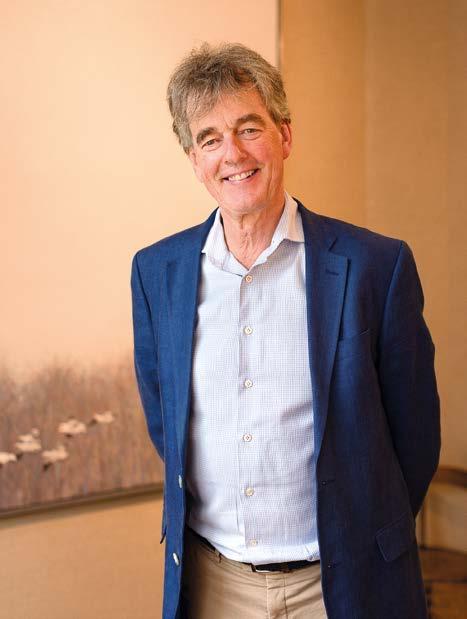

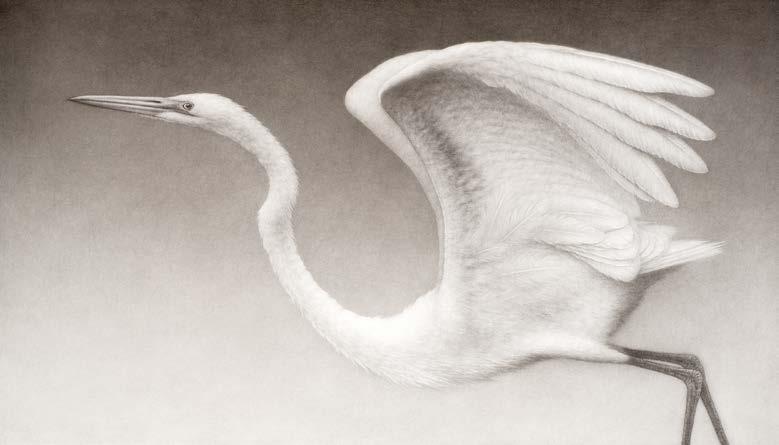

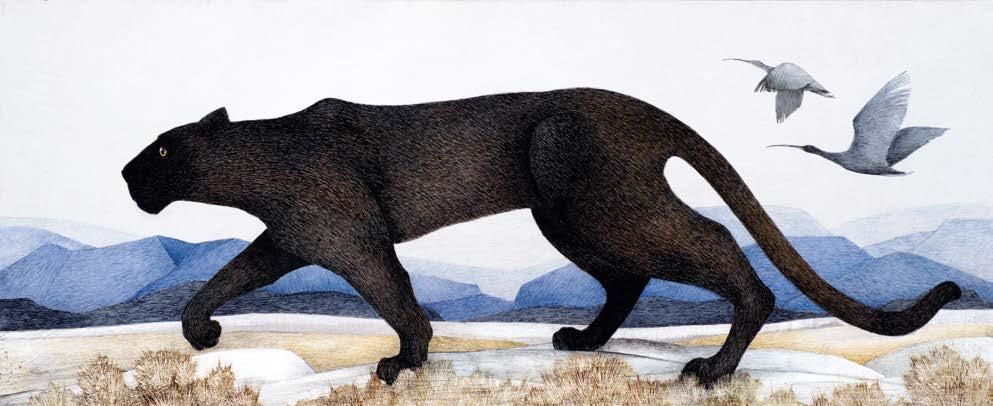
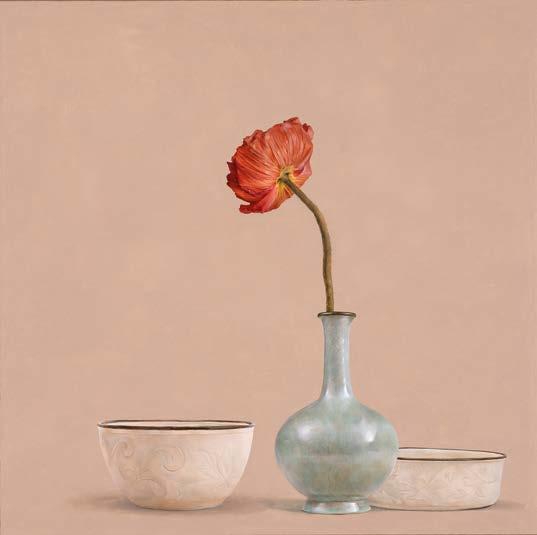






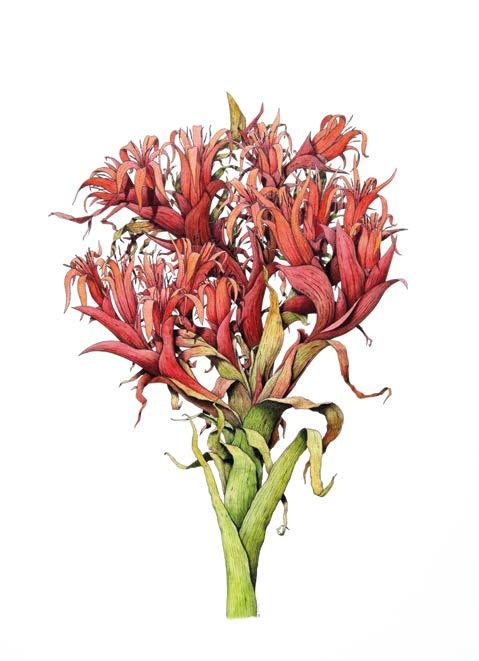


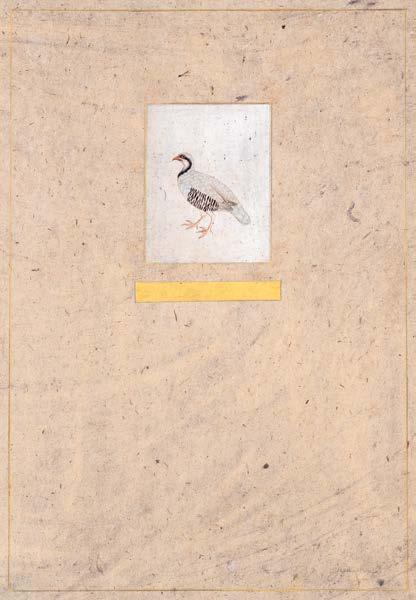

 Cosmos, 2022
Oil on canvas on board 11.22 × 8.86 ins (28.5 × 22.5 cm)
Cosmos, 2022
Oil on canvas on board 11.22 × 8.86 ins (28.5 × 22.5 cm)

